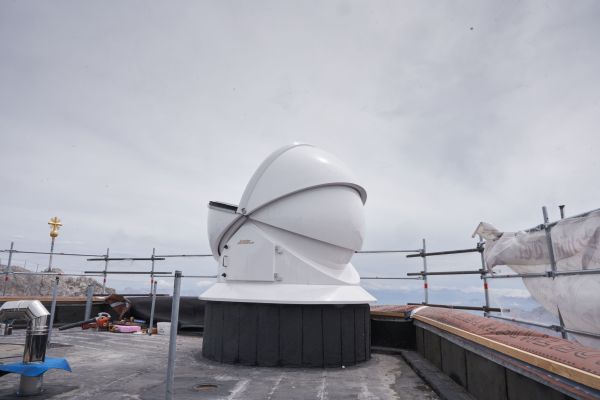Observation of trace gases, aerosols, and clouds is an important basis for understanding climate change and developing adaptation strategies. For this purpose, researchers of Karlsruhe Institute of Technology (KIT) use an observatory on Zugspitze mountain, among others. On July 24/25, 2023, this observatory was provided with a new dome that allows for the use of two remote sensing methods at the same time. Together with the measurement stations at Schneefernerhaus and in Garmisch-Partenkirchen, the observatory is operated by KIT. As parts of the European research infrastructure ACTRIS, they are presently being equipped with latest instruments.
The Atmospheric Environmental Research Department of the Institute of Meteorology and Climate Research (IMK-IFU), KIT’s Campus Alpine, operates the three observatories on Zugspitze mountain (2964 m above sea level, a. s. l.), at Schneefernerhaus (2650 m a. s. l.), and in Garmisch-Partenkirchen (734 m a. s. l.). “This results in one of the best equipped atmosphere observation locations in the world,” says atmosphere physicist Dr. Ralf Sussmann, who heads IMK-IFU’s “Atmospheric Variability and Trends” Group. He and his team are responsible for the observatories. The researchers use various optical methods to measure concentrations of trace gases and the properties of clouds and aerosols up to 70 km height. Thanks to the high altitude, measurements on Zugspitze are representative of large geographical areas. Methane measurements made there are representative of the entire northern hemisphere.

of about 30 trace gases. (Photo: Amadeus Bramsiepe, KIT)
Trace Gases: Harmful to Health and Climate-forcing?
Work focuses in particular on the investigation of trace gases in the atmosphere. Researchers use solar infrared absorption spectrometry to analyze the broad-band spectrum of sunlight. Doing this, concentrations of about 30 different trace gases, including carbon dioxide, methane, nitrogen dioxide, ammonia, ethane, and ozone, are obtained. “For methane, we have observed a sharp increase since 2007,” Sussmann says. “This is an alarming result, as methane is extremely climate-forcing. Some trace gases, such as nitrogen dioxide, are harmful to health. They irritate the eyes, the respiratory passages, and the lungs. Lately, more and more ammonia has entered the atmosphere. This has not yet been studied, but we expect exciting and important results.”

three observatories operated by KIT’s Campus Alpine in Garmisch-Partenkirchen.
(Photo: Amadeus Bramsiepe, KIT)
Worldwide Network Supplies Data for Climate Research
The three observatories of KIT’s Campus Alpine in Garmisch-Partenkirchen are part of the European research infrastructure ACTRIS (stands for Aerosol, Clouds and Trace Gases Research Infrastructure). The network is designed to collect and compare measurement data of equivalent quality at about 100 places worldwide. For this purpose, new sun photometers will be set up on Zugspitze and in Garmisch-Partenkirchen to measure data on aerosols and clouds for 20 years at least. In addition, new lidar-based measurement instruments will be installed. They use lasers to measure the exact altitudes of different particles. An infrared spectrometer in Garmisch will contribute new data on reactive trace gases to ACTRIS.
The new installations required a complete refurbishment of the interior and roof area of Germany’s highest research laboratory. The high altitude caused the work to be rather challenging. It was carried out in close cooperation with KIT’s Planning and Construction Projects Business Unit and the support of Bayerische Zugspitzbahn (BZB, Zugspitze Mountain Railway Company). A first highlight of the refurbishment was the exchange of the observatory dome on Zugspitze. On July 24 and 25, 2023, the old split dome of 1994 was replaced by a new one that can be opened down to waist level and enables use of two remote sensing methods without the dome having to be adjusted.
More Information:
Institute of Meteorology and Climate Research – Atmospheric Environmental Research
Atmospheric Variability and Trends Group at IMK-IFU
Research infrastructure ACTRIS
Details on the KIT Climate and Environment Center
Being “The Research University in the Helmholtz Association”, KIT creates and imparts knowledge for the society and the environment. It is the objective to make significant contributions to the global challenges in the fields of energy, mobility, and information. For this, about 10,000 employees cooperate in a broad range of disciplines in natural sciences, engineering sciences, economics, and the humanities and social sciences. KIT prepares its 22,800 students for responsible tasks in society, industry, and science by offering research-based study programs. Innovation efforts at KIT build a bridge between important scientific findings and their application for the benefit of society, economic prosperity, and the preservation of our natural basis of life. KIT is one of the German universities of excellence.

